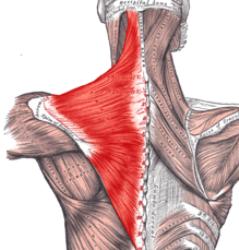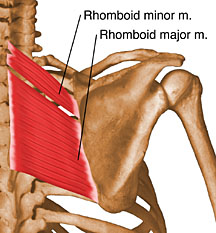I would say that most of my posts this month will be on running as I have a big race coming up on February 2nd (less than 4 weeks away.. yikes!) , but in general I will be posting a lot about effective exercises in the gym and I want to highlight one here….
The Mid Trap Shrug is an exercise that you will read very little about (over the last 25 years I have seen it written about 2 or 3 times) and you will almost never see it done at the gym.. but that has nothing to do with the effectiveness of the exercise.. it simply has to do with ignorance to its legitimacy.
Most everyone reading this knows of standard shrugs for the trapezius muscle. You grab a barbell, a pair of dumbbells, a Smith Machine bar, a cable handle or a plate loaded machine like Hammer Strength and (either standing or seated) with your arms relaxed and at your sides you shrug your shoulders up, crunch your upper traps, try and touch your shoulders to your ears, hold it and release back down. Your traps are a muscle group that responds better to both heavy weight and higher reps (up to 25 reps but also down to 6 reps). Singles or even triples are pointless with shrugs. They need to burn and be exhausted.
Mid Trap Shrugs are meant to hit the middle and lower traps while also working the rhomboids very effectively. Many reading this may not know how large of muscles the traps and rhomboids are. You may think of the traps as only the muscles that you see coming out of your neck and attaching into your shoulder (because this is what you can see when looking in the mirror) but they are actually pretty large muscles that go down your back and help to stabilize your upper spine. In regards to the rhomboids, many would not even be able to point them out.. so I present the two images below (the first being the trapezius) for you to get a better understanding of these muscles.
The Mid Trap Shrug most effectively works the mid to lower traps and both the minor and major rhomboids. The utility of doing this exercise is not only a more complete upper back look, better muscular balance when doing heavy posterior chain work, more strength to get over a specific sticking point during the pull of the deadlift, but also more strength to stay upright and perpendicular to the ground in running.
I want to touch on the running aspect for a moment… one of the key points throughout the life of this blog will be the importance of core, upper back, shoulder, glute, trap and intercostal strength for the ability to hold your torso upright easily throughout the duration of a run (training or race). Getting your traps and rhomboids strong is one part of helping to ensure this. Every time you push your arms back and forward to help propel you forward during your run, you are using both of these muscles. (directly or indirectly). If you have ever felt your upper back sore after a marathon, ultra or particularly tough long run.. these are two of the muscles that were worked hard and are telling you that through the soreness.
On to the exercise… the movement itself is simple and short in length. Essentially.. with your arms out in front of you (as opposed to at your sides) you pull your shoulders back and crunch each side of your upper back towards each other. Your arms stay relaxed but straight. Don’t forcefully lock your arms.. keep them comfortable with the elbows slightly bent, but you are using them as hooks to the weight not pulling in with them (as you would with bent over rows). You will feel what muscles are being worked from almost the first rep.
Here is a link to show you the exercise being done with dumbbells on an incline bench. This is a legitimate way to do the exercise. I feel that the less of an incline the better (approaching a flat bench) but it becomes logistically challenging to do the exercise with dumbbells as you get closer to flat because your arms hit the floor. With some benches, it is possible to do this exercise with a barbell and that can be a great way to add more weight.
I am a fan of using the incline bench with free weights to do this movement, but I would say I prefer (for ease of performing the movement) using a cable/pulley/machine set up. Get set as if you are going to do a seated row (either with a cable or a machine.. plate loaded like Hammer Strength or pin selected) and fully stretch forward with straight arms (but while keeping your torso perpendicular to the ground.. don’t lean far forward much because this does not benefit the movement) and then (with arms still straight) pull your shoulder blades (scapula) directly back and toward each other. Hold for a second and then release forward again and stretch as far as you can without moving your torso forward much. Feel the forward stretch and then repeat. This is one movement where there is a real muscle/mind connection and you will feel them as they work. It is a good feeling. Do this movement relatively slow to stay safe and get a better stretch of the muscle. Rep ranges should be from 6 – 20 and go as heavy as you can for those ranges. 4 – 8 total sets for the traps is more than adequate for the novice to intermediate trainee. Advanced trainees could go up to 10. As with most major muscle groups (but that is another post) these muscles only need to be worked once a week and are good to combine with your lat work.
You can do both regular shrugs and mid trap shrugs in the same session (would do regular shrugs first) or you can substitute them on different training days.
I believe this seldom used exercise can make a significant difference in your overall back development and make those later miles in your race more comfortable and strong!
Let me know if there are any questions.
Thank you.
Chris

